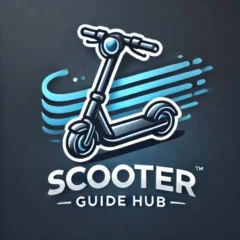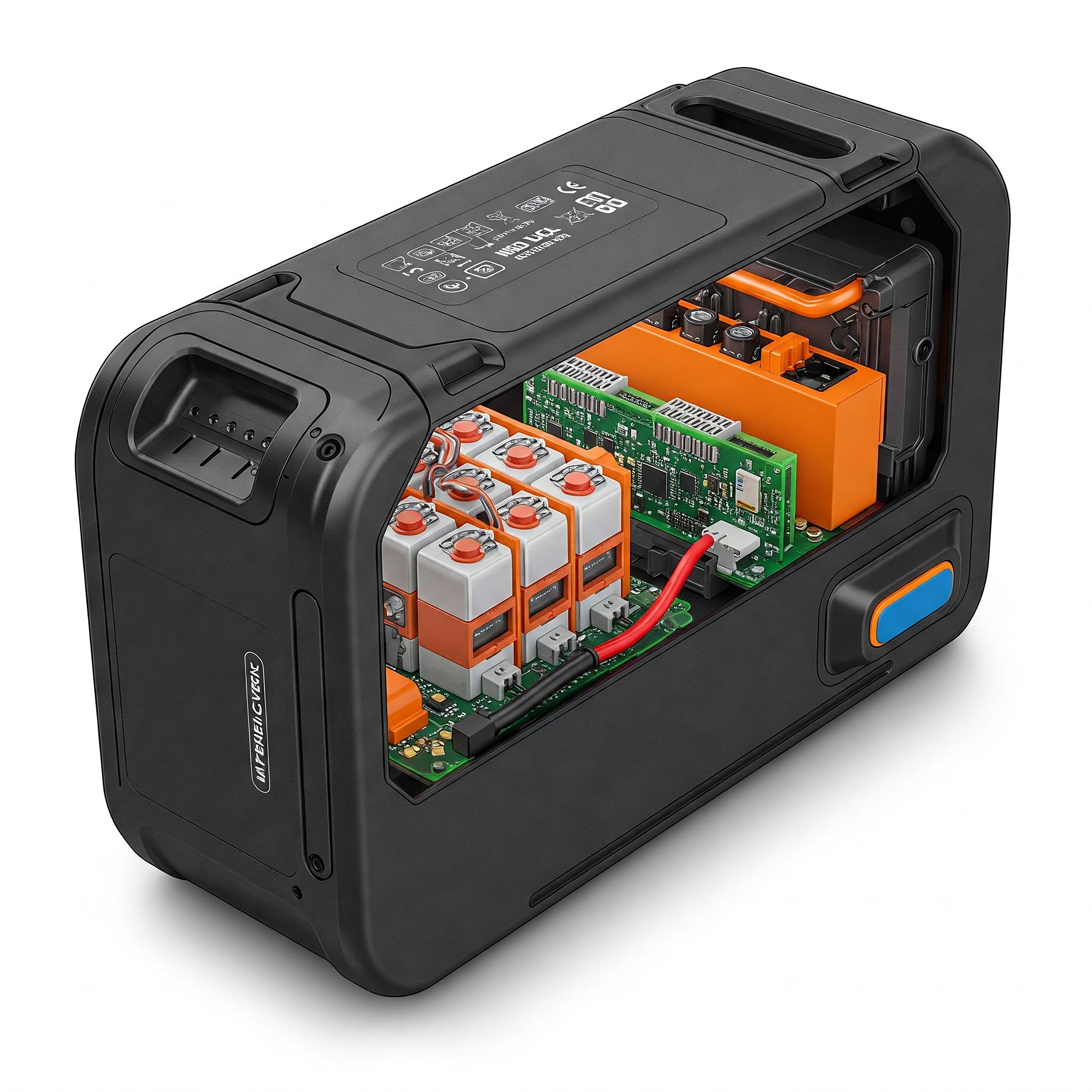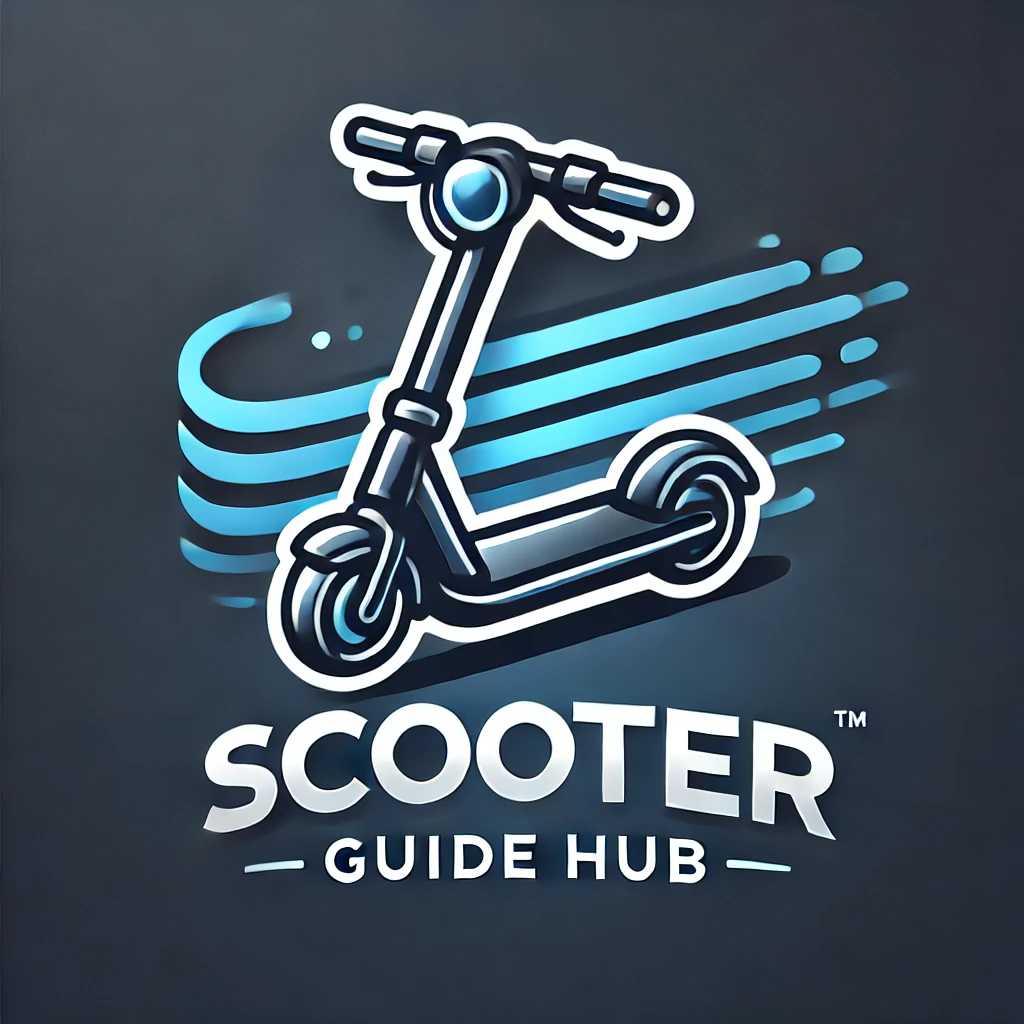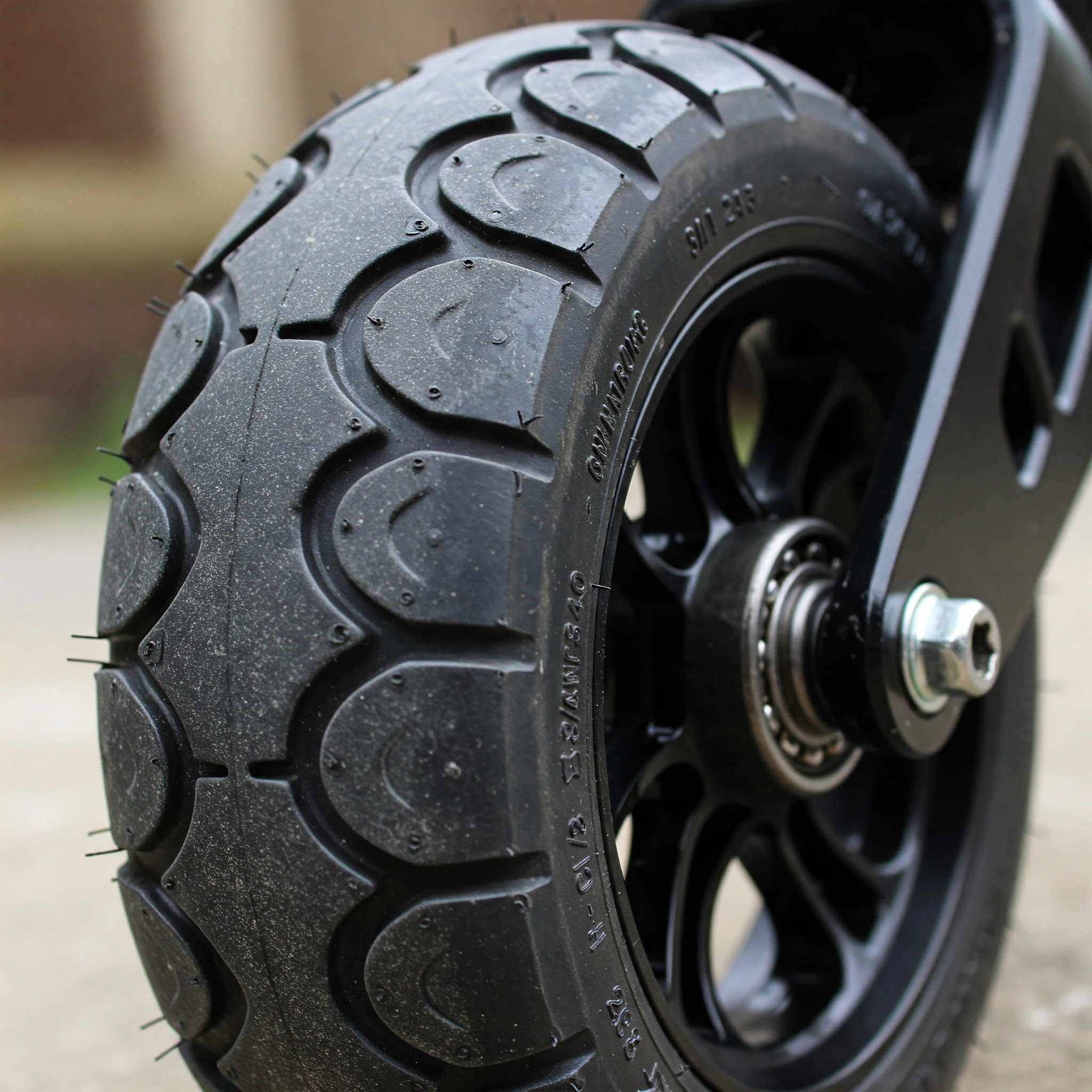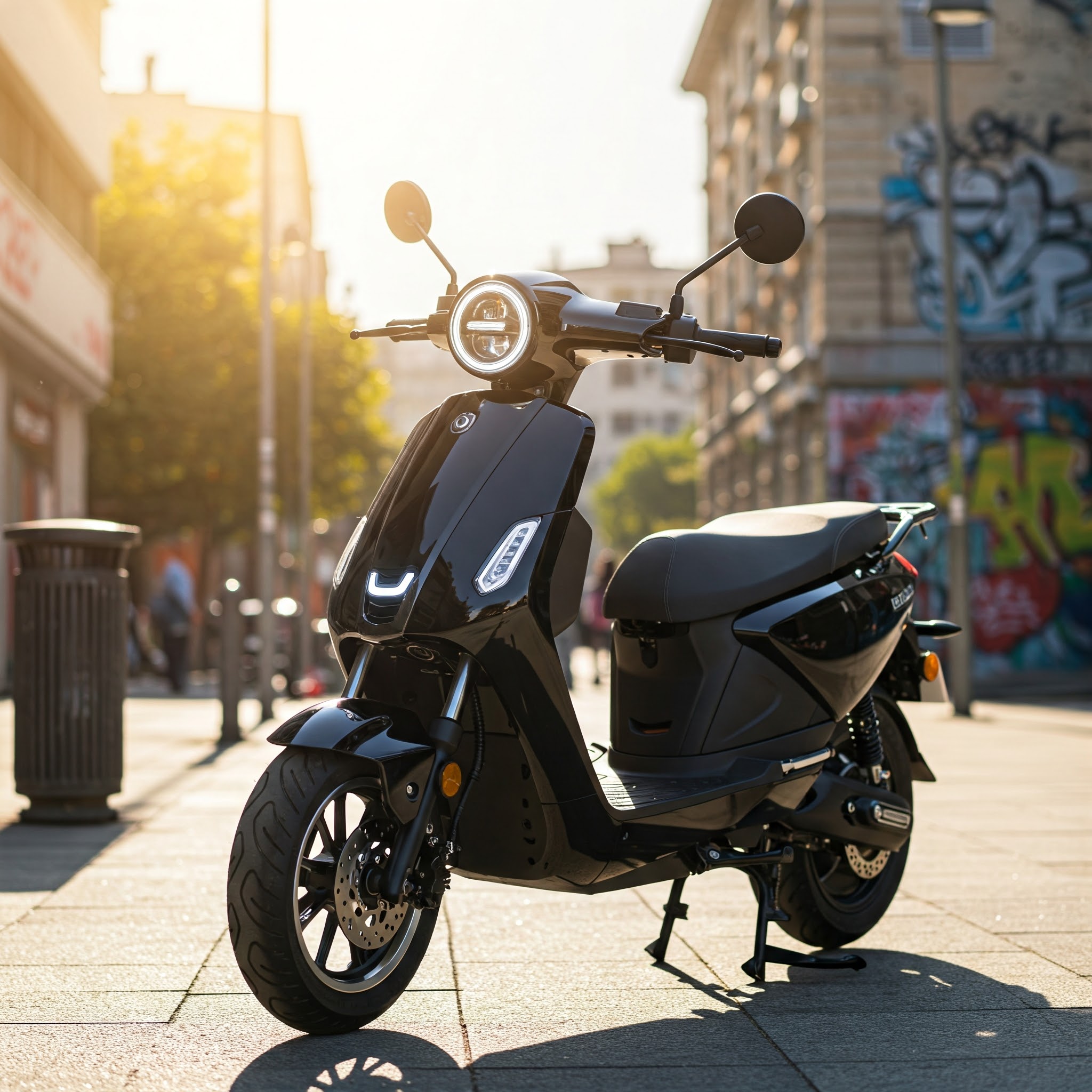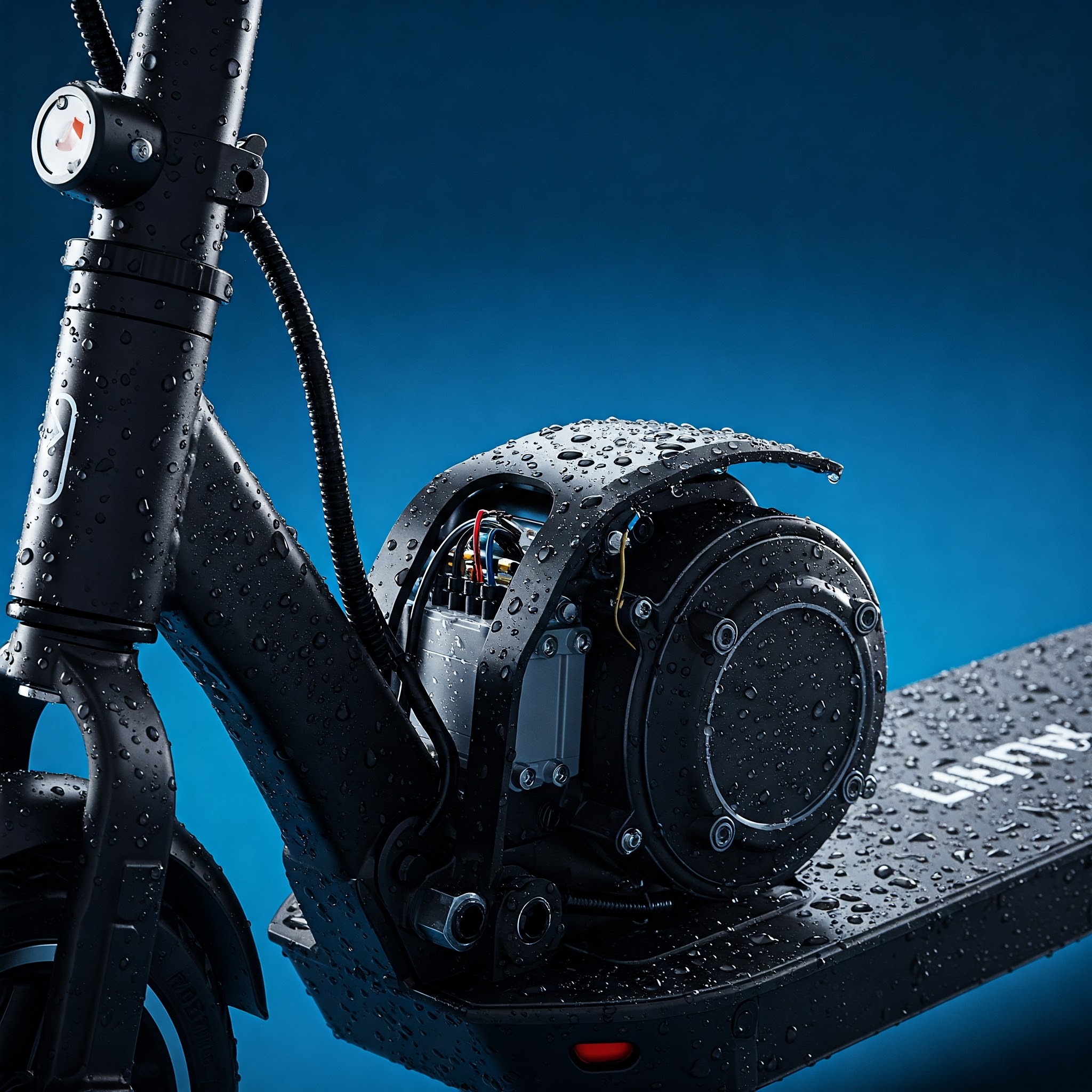Are you fascinated by the convenience and eco-friendly nature of electric transportation? If you’re an electric moped scooter enthusiast or looking to dive into this exciting world, understanding the various electric moped scooter parts is essential for proper maintenance, performance upgrades, and troubleshooting. As someone who’s been riding, repairing, and upgrading electric mopeds for over a decade, I’m excited to share my knowledge with you.
✨Was this helpful? Spread the word! 🚀
Electric moped scooters have revolutionized urban transportation with their efficient design, cost-effectiveness, and minimal environmental impact. However, like any vehicle, they comprise numerous components that work together to provide that smooth, enjoyable ride we all love. From the powerful motors to the sophisticated battery systems, each part plays a crucial role in your moped’s performance and longevity.
In this comprehensive guide, we’ll explore everything you need to know about electric moped scooter parts—from the basic components to advanced upgrades. Whether you’re a beginner trying to understand your new ride or an experienced rider looking to enhance performance, this article has something valuable for everyone.
Comparing Electric Moped Scooters to Other Transportation Options
Before diving into specific parts, let’s understand how electric moped scooters compare to other transportation alternatives:
| Feature | Electric Moped Scooter | Traditional Gas Scooter | Electric Bicycle | Electric Skateboard |
|---|---|---|---|---|
| Average Speed | 20-45 mph | 30-65 mph | 15-28 mph | 10-25 mph |
| Range | 40-80 miles | 100-200 miles | 20-60 miles | 10-25 miles |
| Cost to Operate | $0.01-0.03/mile | $0.08-0.12/mile | $0.01/mile | $0.01/mile |
| Parts Availability | Moderate | High | High | Limited |
| Maintenance Complexity | Moderate | High | Low | Low |
| Environmental Impact | Very Low | High | Very Low | Very Low |
| Storage Requirements | Moderate | Moderate | Small | Very Small |
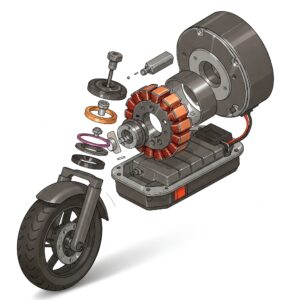
Now, let’s explore the essential components that make up your electric moped scooter and understand their functions, maintenance requirements, and upgrade options.
1. Electric Motors: The Heart of Your Moped Scooter
The electric motor is arguably the most critical component of any electric moped scooter. It’s responsible for converting electrical energy from the battery into mechanical energy that propels your vehicle forward.
Types of Electric Motors Used in Moped Scooters
Electric moped scooter parts include various types of motors, each with distinct characteristics:
Hub Motors
Hub motors are integrated directly into the wheel hub, eliminating the need for chains, belts, or gears. They come in two variations:
✅ Direct Drive Hub Motors: These motors have fewer moving parts, resulting in less maintenance and quieter operation. However, they tend to be heavier and generate heat during braking.
✅ Geared Hub Motors: These incorporate internal gearing systems, making them more efficient for hill climbing and acceleration. They’re lighter but may require more maintenance over time.
Mid-Drive Motors
Mid-drive motors are mounted near the pedal area and connect to the rear wheel through the same chain or belt drive as the pedals. This configuration offers:
✅ Better weight distribution for improved handling
✅ More efficient power use, especially on hills
✅ Easier maintenance of wheels (since the motor isn’t in the hub)
✅ Enhanced torque leveraging the bike’s gears
When looking for replacement motors, one excellent option is the VEVOR 48V 1000W Brushless Motor Kit. This versatile motor kit offers excellent torque and can be installed on various electric moped scooters. The VEVOR 48V 1000W Brushless Motor Kit comes with the controller and all necessary mounting hardware, making it an ideal replacement part for DIY enthusiasts.
Motor Specifications to Consider
When examining electric moped scooter parts related to the motor, pay attention to these key specifications:
- Power Rating (Watts): Most electric moped scooters feature motors ranging from 250W to 2000W. Higher wattage generally means more power and speed.
- Voltage: Typical electric moped motors operate at 24V, 36V, 48V, or 72V. Higher voltage systems generally provide better performance and efficiency.
- Torque: Measured in Newton-meters (Nm), torque determines your scooter’s ability to climb hills and accelerate.
- Efficiency Rating: More efficient motors convert a higher percentage of electrical energy into mechanical power, maximizing battery life.
Maintenance Tips for Electric Motors
To ensure your motor remains in optimal condition:
- Regularly inspect for dirt, debris, or water ingress
- Listen for unusual noises during operation
- Check connectors for corrosion or loose connections
- Monitor temperature during use (excessive heat can indicate problems)
- If using a chain or belt drive system, maintain proper tension
2. Battery Systems: Powering Your Electric Ride
The battery is another critical component among electric moped scooter parts. It stores the electrical energy needed to power your motor and other electrical systems. Battery technology has advanced significantly in recent years, offering improved range, lifespan, and charging times.
Types of Batteries Used in Electric Moped Scooters
Lithium-Ion (Li-ion) Batteries
Currently the most popular choice for electric moped scooters due to their:
- High energy density (more range for the same weight)
- Longer lifespan (typically 500-1000 charge cycles)
- No memory effect
- Lighter weight compared to other options
- Lower self-discharge rate when not in use
Lithium Iron Phosphate (LiFePO4) Batteries
These offer:
- Exceptional safety profile and thermal stability
- Extended lifespan (2000+ charge cycles)
- Better performance in extreme temperatures
- More environmentally friendly composition
- Slightly lower energy density than standard Li-ion
Lead-Acid Batteries
These older-technology batteries are still found in some budget models:
- Lower initial cost
- Heavier weight
- Shorter lifespan (200-300 cycles)
- Lower energy density
- Require more maintenance
For those looking to upgrade their electric moped scooter parts, particularly the battery, I highly recommend the Weize 48V 20Ah Lithium Battery Pack. This Weize 48V 20Ah Lithium Battery Pack offers an excellent balance of capacity, reliability, and value. It’s compatible with most 48V systems and includes built-in BMS (Battery Management System) protection.
Battery Specifications to Consider
When evaluating batteries for your electric moped scooter, pay attention to:
- Voltage: Measured in volts (V), this must match your motor’s requirements.
- Capacity: Measured in ampere-hours (Ah), this determines your range. More Ah means more distance on a single charge.
- Maximum Discharge Rate: This indicates how quickly power can be drawn from the battery, affecting acceleration and hill-climbing ability.
- Cycle Life: The number of complete charge/discharge cycles before the battery degrades to 80% of its original capacity.
- Battery Management System (BMS): This electronic system protects the battery from operating outside its safe operating parameters.
Battery Maintenance and Care
To maximize battery life and performance:
- Avoid completely draining the battery when possible
- Store in a cool, dry place if not using for extended periods
- Maintain charge levels between 20% and 80% for optimal lifespan
- Avoid exposure to extreme temperatures
- Use the manufacturer’s recommended charger
- Periodically balance cells (if your battery system allows it)
3. Controllers: The Brain of Your Electric Moped Scooter
The controller serves as the command center for your electric moped scooter, managing power flow between the battery and motor. This critical component interprets input from the throttle, brakes, and other systems to regulate the motor’s performance.
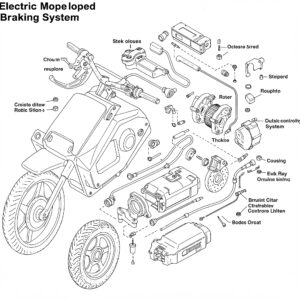
Functions of the Controller
A quality controller manages several crucial aspects of your electric moped scooter’s operation:
✅ Regulates power flow from battery to motor
✅ Controls acceleration and speed
✅ Manages regenerative braking (if equipped)
✅ Protects the system from overheating
✅ Monitors battery voltage and prevents over-discharge
✅ Provides diagnostic information for troubleshooting
Types of Controllers
Basic Controllers
Simple controllers provide fundamental functions like throttle control and basic battery protection. These are commonly found on budget electric moped scooters.
Programmable Controllers
These advanced units allow customization of performance parameters like:
- Maximum speed
- Acceleration rate
- Regenerative braking strength
- Low-voltage cutoff points
- Current limits
For a reliable controller upgrade, consider the BAFANG 48V 750W 25A Controller. This BAFANG 48V 750W 25A Controller is programmable and offers excellent reliability for electric moped scooter parts replacement. Its waterproof design and heat dissipation features make it suitable for various riding conditions.
Controller Specifications to Consider
When selecting a controller for your electric moped scooter:
- Voltage Rating: Must match your battery system (e.g., 36V, 48V, 72V)
- Current Rating: Measured in amps, this determines the maximum power the controller can handle
- Phase Type: Single-phase or three-phase, depending on your motor type
- Features: Look for desirable options like regenerative braking capability, LCD compatibility, and programmability
- Waterproof Rating: Particularly important for outdoor use in various weather conditions
Controller Maintenance Tips
To ensure your controller functions properly:
- Keep it dry and protected from the elements
- Ensure proper ventilation to prevent overheating
- Check wire connections periodically for corrosion or looseness
- Use appropriate tools when adjusting settings
- Backup your settings before making changes (for programmable controllers)
4. Braking Systems: Safety First
Effective brakes are critical safety-related electric moped scooter parts. Unlike gas-powered vehicles, electric moped scooters often utilize both traditional friction brakes and regenerative braking systems.
Types of Braking Systems
Mechanical Disc Brakes
These operate similarly to bicycle disc brakes, using cable actuation to press brake pads against a rotor. Benefits include:
- Reliable stopping power
- Relatively simple maintenance
- Good performance in various weather conditions
- Affordable replacement parts
Hydraulic Disc Brakes
These use hydraulic fluid to transfer force from the brake lever to the caliper. Advantages include:
- Stronger, more consistent braking force
- Less hand fatigue during extended use
- Self-adjusting pads
- Better modulation for controlled stopping
Drum Brakes
Some electric moped scooters use drum brakes, especially on rear wheels. These offer:
- Protection from dirt and water
- Lower maintenance requirements
- Consistent performance over time
- Good durability
Regenerative Braking
This system converts kinetic energy back into electrical energy during braking, recharging the battery while slowing the vehicle. Benefits include:
- Extended range
- Reduced wear on mechanical brake components
- Smoother deceleration
- Energy efficiency
For those looking to upgrade their braking system, I recommend the NUTT Hydraulic Disc Brake Set. This NUTT Hydraulic Disc Brake Set provides exceptional stopping power and includes both front and rear brakes with rotors and all mounting hardware.
Braking System Maintenance
Proper maintenance of your braking system is essential for safety:
- Regularly inspect brake pads for wear and replace when needed
- Check rotors for warping or damage
- Ensure proper cable tension for mechanical brakes
- Bleed hydraulic systems according to manufacturer recommendations
- Test brake function before each ride
- Keep rotors clean and free from oils or lubricants
5. Suspension Systems: Ensuring a Smooth Ride
Quality suspension is essential for comfort, control, and safety on your electric moped scooter, particularly when navigating uneven terrain or potholes.
Common Suspension Components
Front Suspension
Most electric moped scooters utilize one of these front suspension types:
✅ Telescopic Forks: Similar to those found on motorcycles, these provide smooth compression and rebound for comfortable riding.
✅ Dual Crown Forks: Offering increased stability and strength, these are ideal for off-road or heavy-duty applications.
✅ Spring Suspension: Simple, economical systems using coil springs to absorb impacts.
Rear Suspension
Rear suspension options typically include:
✅ Dual Shock Absorbers: Mounted on either side of the rear wheel, these provide balanced compression and stability.
✅ Monoshock Systems: A single, centrally-located shock absorber that provides efficient dampening with less weight.
✅ Swing Arm Suspension: Allows the rear wheel to move up and down while maintaining chain tension.
For suspension upgrades, the DNM AOY-36RC Rear Shock Absorber is an excellent choice. This DNM AOY-36RC Rear Shock Absorber offers adjustable rebound and compression, allowing you to customize your ride for different conditions and rider weights.
Suspension Maintenance
To keep your suspension system performing optimally:
- Regularly inspect for leaks (oil or air)
- Check mounting hardware for tightness
- Maintain proper air pressure in air suspension systems
- Lubricate moving parts according to manufacturer specifications
- Adjust preload, compression, and rebound settings for your weight and riding style
- Replace worn seals and bushings as needed
Comparing Different Electric Moped Scooter Models by Suspension Quality
| Model Type | Front Suspension | Rear Suspension | Ride Quality | Best For |
|---|---|---|---|---|
| Budget Models | Basic spring forks | Dual springs or none | Fair | Smooth pavement |
| Mid-Range Models | Hydraulic telescopic forks | Dual shock absorbers | Good | Urban riding with occasional bumps |
| Premium Models | Adjustable inverted forks | Adjustable monoshock | Excellent | Various terrains and conditions |
| Off-Road Models | Long-travel reinforced forks | High-clearance heavy-duty shock | Rugged | Rough terrain and jumps |
💬 Just one click – help others make better buying decisions too!😊
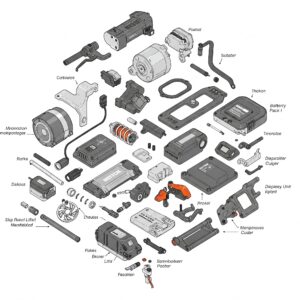
6. Wheels and Tires: Where Rubber Meets the Road
Wheels and tires are critical electric moped scooter parts that affect stability, traction, comfort, and overall riding experience. Selecting the right options for your riding environment and style can significantly enhance performance.
Wheel Types and Considerations
Electric moped scooters typically use:
Spoked Wheels
Traditional design offering:
- Lighter weight
- Ability to absorb small impacts
- Easier and more economical to repair
- Classic aesthetic
Cast Alloy Wheels
Modern alternative providing:
- Greater strength and rigidity
- Tubeless tire compatibility
- Less maintenance
- Contemporary look
Tire Types for Electric Moped Scooters
Pneumatic (Air-Filled) Tires
These come in tube and tubeless variants, offering:
- Superior shock absorption
- Better traction on various surfaces
- More comfortable ride
- Increased stability
Solid Tires
Made from solid rubber or polymer, these provide:
- Zero maintenance (no flats)
- Longer lifespan
- Consistent performance
- No air pressure concerns
Semi-Solid Tires
A hybrid approach featuring:
- Honeycomb or foam-filled design
- Better shock absorption than solid tires
- Puncture resistance
- Reduced maintenance compared to pneumatic tires
For those looking to upgrade their electric moped scooter parts related to tires, I recommend the Kenda K761 Tire Set. These Kenda K761 Tire Set tires offer excellent grip in both wet and dry conditions while providing good durability for daily commuting.
Wheel and Tire Maintenance
Proper care ensures optimal performance and safety:
- Maintain correct tire pressure
- Regularly inspect for wear, cuts, or embedded objects
- Check wheel alignment and trueness
- Ensure spokes are tensioned correctly (for spoked wheels)
- Clean and lubricate wheel bearings periodically
- Rotate tires to promote even wear (if your configuration allows)
7. Lighting Systems: Visibility and Safety
Proper lighting is essential for both visibility and legal compliance. Most jurisdictions require at least front and rear lights for road use, especially during nighttime operation.
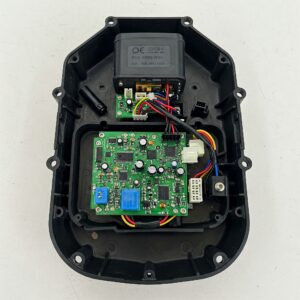
Essential Lighting Components
Headlights
The primary forward illumination system, available in various configurations:
✅ LED Headlights: Offering bright, energy-efficient illumination with long lifespans
✅ Multiple Beam Patterns: High/low capabilities for different riding conditions
✅ Smart Lighting: Automatic adjustment based on ambient light conditions
Taillights
Rear lighting serves multiple functions:
✅ Brake Light Function: Intensifies when braking to alert following traffic
✅ Running Lights: Constant illumination for visibility
✅ Turn Signals: Indicating directional changes to other road users
Additional Lighting
Many electric moped scooters incorporate:
✅ Turn Signals: Front and rear indicators for lane changes and turns
✅ Underglow Lighting: Decorative lights that also enhance side visibility
✅ Daytime Running Lights (DRL): Improving daytime visibility
For a comprehensive lighting upgrade, the WUPP Moped Scooter Light Kit is an excellent choice. This WUPP Moped Scooter Light Kit includes a bright LED headlight, taillight with brake function, and turn signals, all with weatherproof wiring.
Lighting System Maintenance
To ensure your lighting system remains functional:
- Regularly check all lights for proper operation
- Clean lenses to maintain maximum brightness
- Inspect wiring connections for corrosion or damage
- Carry spare bulbs (if not using LED systems)
- Test brake light function regularly
- Ensure proper alignment of headlights
8. Throttle and Control Systems: Interface With Your Machine
The throttle and control systems serve as your primary interface with the electric moped scooter, translating your inputs into vehicle actions.
Types of Throttle Controls
Twist Throttles
Similar to motorcycle throttles, these are rotated with the wrist to control speed:
- Intuitive for most riders
- Good fine control for variable speeds
- Familiar to motorcycle riders
- Available in half-twist or full-twist configurations
Thumb Throttles
Operated by pressing a lever with the thumb:
- Reduced wrist fatigue on long rides
- Less likely to cause accidental acceleration
- Easier to maintain a steady speed
- Popular on e-bike conversions
Combination Throttles
These integrate multiple functions:
- Battery level indicators
- Power mode selection
- Regenerative braking control
- Speed display
The Bafang LCD Display with Thumb Throttle is a great upgrade for your electric moped scooter. This Bafang LCD Display with Thumb Throttle combines throttle control with an information display showing speed, battery level, and trip data.
Control System Components
Modern electric moped scooters feature various control elements:
- LCD Displays: Providing information on speed, battery level, and system status
- Mode Selectors: Allowing riders to choose between power modes (eco, normal, sport)
- Integrated Controls: Combining brakes, signals, and horn in ergonomic packages
- Smart Controls: Bluetooth connectivity for smartphone integration and customization
Control System Maintenance
Keeping your control systems in top condition:
- Protect from water and extreme weather
- Clean contacts with electrical contact cleaner
- Check for loose connections or damaged wires
- Update firmware when available (for digital systems)
- Lubricate moving parts like throttle mechanisms
9. Frame and Body Components: Structure and Style
The frame and body components not only define the look of your electric moped scooter but also provide structural integrity and protection for critical systems.
Frame Considerations
Electric moped scooter parts related to the frame include:
Frame Materials
Common options include:
✅ Steel: Offering strength, durability, and relatively easy repairs, but heavier than alternatives
✅ Aluminum: Providing a good balance of strength and weight reduction
✅ Carbon Fiber: Premium option delivering exceptional strength-to-weight ratio, but at a higher cost
Frame Design Types
Various configurations exist:
✅ Step-Through: Easy mounting and dismounting, popular for urban commuters
✅ Tubular: Traditional motorcycle-inspired design with greater rigidity
✅ Monocoque: Integrated body and frame for sleek aesthetics and aerodynamics
Body Panels and Fairings
These components provide:
- Weather protection
- Aerodynamic benefits
- Storage integration
- Customization opportunities
- Protection for electrical components
For those looking to customize their electric moped scooter parts related to body components, the Universal Scooter Windshield offers both style and functionality. This Universal Scooter Windshield reduces wind resistance and protects riders from debris while enhancing the overall look of your electric moped.
Frame and Body Maintenance
To maintain these structural components:
- Regularly inspect for cracks or damage
- Keep fasteners tight and properly torqued
- Touch up paint chips to prevent corrosion
- Clean thoroughly, especially after riding in salt or chemicals
- Apply appropriate protectants based on material type
Comparing Motor, Battery and Controller Combinations for Different Riding Needs
| Riding Style | Recommended Motor | Ideal Battery | Controller Type | Best For |
|---|---|---|---|---|
| Urban Commuting | 500-750W Hub Motor | 48V 10-15Ah Lithium | Standard with regenerative braking | Efficient daily transportation |
| Performance Riding | 1000W+ Mid-Drive | 52V 20Ah+ Lithium | Programmable with multiple modes | Thrilling recreational rides |
| Long Range Touring | 750W Efficient Hub | 48V 20Ah+ or Dual Batteries | Energy-optimized with smart features | Extended journeys |
| Off-Road Adventure | 1500W+ High-Torque | 72V 20Ah+ LiFePO4 | Heavy-duty programmable | Challenging terrain |
💬 Just one click – help others make better buying decisions too!😊
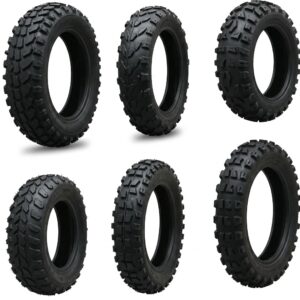
10. Charging Systems: Keeping Powered Up
A reliable charging system is essential for convenient electric moped scooter ownership. Understanding charger specifications and best practices helps maintain battery health and ensures your scooter is always ready to ride.
Charger Types and Specifications
Standard Chargers
Basic chargers that come with most electric moped scooters:
- Fixed charging rate
- Simple operation
- Limited features
- Typically 2-8 hour charging time
Fast Chargers
Upgraded options for reduced charging time:
- Higher amperage output
- Reduced charging time (1-4 hours)
- May generate more heat
- Sometimes feature cooling systems
Smart Chargers
Advanced options with additional features:
- Multiple charging modes (fast, balanced, storage)
- Battery maintenance functions
- Diagnostic capabilities
- Temperature monitoring
- Automatic shutdown when complete
For a reliable charging upgrade, I recommend the YZPOWER 58.8V 5A Smart Charger. This YZPOWER 58.8V 5A Smart Charger offers fast charging capability with multiple safety features and is compatible with most 48V lithium battery systems.
Charging Best Practices
Follow these guidelines to maximize battery life and safety:
- Use the manufacturer’s recommended charger or compatible equivalent
- Charge in a well-ventilated area away from extreme temperatures
- Avoid leaving the battery on the charger for extended periods after completion
- Don’t charge immediately after riding (let the battery cool first)
- Disconnect during electrical storms
- Periodically inspect charging ports and cables for damage
Key Considerations When Upgrading Electric Moped Scooter Parts
When upgrading or replacing components on your electric moped scooter, keep these factors in mind:
Compatibility
Ensure new parts work with your existing systems:
- Voltage compatibility between battery, motor, and controller
- Physical mounting considerations
- Connector types and wiring compatibility
- Software/firmware compatibility for digital components
Performance Goals
Clarify what you want to achieve with upgrades:
- Increased range
- Higher top speed
- Better acceleration
- Improved comfort
- Enhanced safety
- More reliability
Legal Considerations
Be aware of regulations that may affect modifications:
- Power/speed limits in your jurisdiction
- Licensing requirements based on performance characteristics
- Required safety equipment
- Insurance implications
💥 Take Your Electric Moped Scooter to the Next Level! 💥
➡ Ready to upgrade your ride with premium electric moped scooter parts? The products mentioned throughout this article represent some of the best options available for enhancing performance, comfort, and reliability. Click on any highlighted product to check current pricing and availability on Amazon!
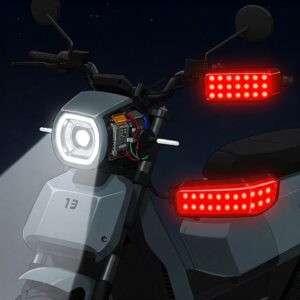
DIY Maintenance vs. Professional Service
Deciding between DIY maintenance and professional service depends on your comfort level, tools, and the complexity of the task.
Suitable DIY Maintenance Tasks
Most riders can handle:
- Basic cleaning and lubrication
- Tire pressure checks and adjustments
- Brake pad replacement
- Light bulb replacement
- Basic battery maintenance
- Minor adjustments (throttle, brakes, etc.)
When to Seek Professional Service
Consider professional help for:
- Complex electrical diagnostics
- Motor rebuilding or replacement
- Battery cell balancing or repair
- Controller programming or firmware updates
- Structural repairs
- Warranty-related issues
For DIY maintenance, a quality toolkit is essential. The YOOHE 53-Piece Scooter Tool Kit includes everything needed for basic maintenance. This YOOHE 53-Piece Scooter Tool Kit comes with specialized tools for electric vehicle maintenance in a convenient carrying case.
Essential Maintenance Schedule for Electric Moped Scooter Parts
| Maintenance Task | Frequency | DIY Difficulty |
|---|---|---|
| Check tire pressure | Weekly | Easy |
| Inspect brake function | Before each ride | Easy |
| Clean external surfaces | Bi-weekly | Easy |
| Check and tighten fasteners | Monthly | Easy |
| Clean and lubricate chain (if applicable) | Monthly | Moderate |
| Check wheel alignment | Monthly | Moderate |
| Inspect electrical connections | Quarterly | Moderate |
| Test battery capacity | Quarterly | Easy |
| Check/adjust brakes | Quarterly | Moderate |
| Inspect suspension components | Quarterly | Moderate |
| Motor inspection | Bi-annually | Difficult |
| Battery cell balancing | Annually | Difficult |
| Controller diagnostics | Annually | Difficult |
Future Trends in Electric Moped Scooter Parts
The electric moped scooter industry continues to evolve rapidly. Here are some exciting developments to watch for:
Battery Technology Advancements
- Solid-state batteries with higher energy density and faster charging
- Battery swapping systems for instant “refueling”
- Improved battery management systems for longer lifespan
- Lightweight, flexible battery designs
Motor Innovations
- More efficient motors with reduced weight
- Integrated motor-wheel designs
- Dual-motor systems for improved traction and performance
- Advanced cooling systems for sustained high performance
Smart Systems Integration
- AI-enhanced riding modes adapting to conditions
- Advanced connectivity with smartphones and wearables
- Predictive maintenance alerts
- Over-the-air updates for controllers and systems
🚀 Ready to Enhance Your Electric Moped Scooter? 🚀
➡ Don’t wait to improve your riding experience! Check out the high-quality replacement parts and upgrades mentioned throughout this article. These carefully selected components can transform your electric moped scooter with better performance, enhanced comfort, and increased reliability. Click any highlighted product to see current prices and availability!
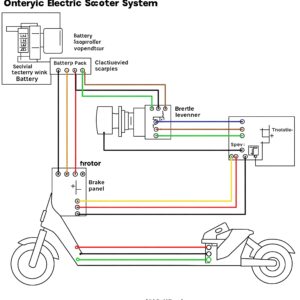
Conclusion
Understanding electric moped scooter parts is essential for proper maintenance, effective troubleshooting, and smart upgrades. Each component—from the motor and battery to the controller and charging system—plays a vital role in your electric moped scooter’s performance, reliability, and riding experience.
By familiarizing yourself with these components and their functions, you’re better equipped to make informed decisions about maintenance, repairs, and upgrades. Regular preventative maintenance and quality replacement parts will extend the life of your electric moped scooter while ensuring optimal performance and safety.
Whether you’re a daily commuter, weekend joy rider, or serious enthusiast, the knowledge shared in this guide will help you get the most from your electric moped scooter experience. As technology continues to advance, we can look forward to even more efficient, powerful, and reliable electric moped scooter parts in the future.
More FAQs
❓ How much does it cost to replace an electric moped scooter battery?
✅ Typically between $150-$600 depending on voltage and capacity... Quality lithium batteries for electric moped scooters average $300-400 for a 48V 15-20Ah unit, while premium options with longer cycle life can exceed $600...
❓ What's the average lifespan of an electric moped scooter motor?
✅ With proper maintenance, 3,000-8,000 miles or 3-5 years of regular use... Quality hub motors typically last longer than budget options, while keeping motors clean and preventing overheating significantly extends lifespan...
❓ Can I upgrade my electric moped scooter controller for more speed?
✅ Yes, but with important considerations... While upgrading to a higher-amp controller can increase performance, it must be compatible with your motor and battery specifications. Ensure your battery can handle increased current draw...
❓ What tools do I need for basic electric moped scooter maintenance?
✅ A quality multimeter, hex key set, socket set, tire pressure gauge, and cable cutters... For electrical components, also include a soldering iron, heat shrink tubing, electrical tape, and various connectors. A battery tester is highly recommended...
❓ How often should I replace brake pads on my electric moped scooter?
✅ Every 1,000-1,500 miles depending on riding conditions and brake usage... Inspect pads monthly for wear—replace when less than 1.5mm thick. Riders in hilly areas or those who brake frequently may need replacements more often...
Recommended for You:
- 10 Best Electric Scooter Lights for Maximum Visibility & Safety in 2025
- 10 Best Waterproof Electric Scooter Models For All-Weather Commuting in 2025
- 10 Amazing Electric Scooter 2 Seat Options That Will Transform Your Daily Commute in 2025
Disclaimer: This article contains affiliate links. If you purchase products through these links, we may earn a small commission at no additional cost to you.
✨ Found this helpful? Share it with your friends! 💬🤗
